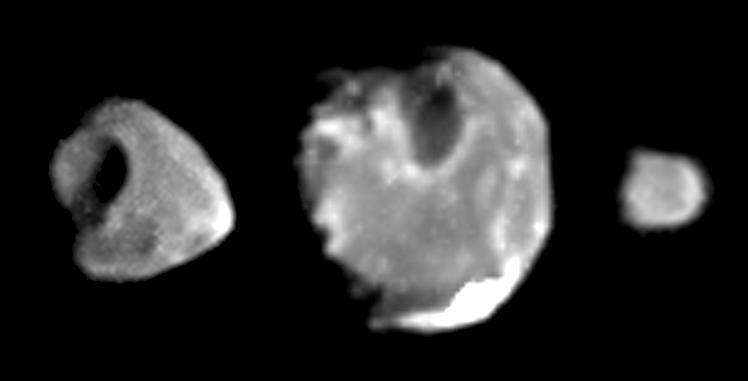Amalthea

Discovery
Amalthea was discovered Sept. 9, 1892 by Edward Emerson Barnard.
Overview
Orbiting within Io's orbit, which is the innermost of the four largest moons of Jupiter (called the Galilean moons), are four smaller moons named Metis, Adrastea, Amalthea, and Thebe.
All of the moons within this grouping are oddly shaped, lacking either the mass and/or fluidity of composition to pull themselves into a reasonably spherical shape. The Galileo spacecraft has revealed some surface features, including impact craters, hills, and valleys.
Amalthea is the largest within this grouping with a mean radius of about 83.5 ± 2.4 km. Amalthea orbits 181,400 km from its parent planet, Jupiter. Amalthea takes 0.498 Earth days to complete one orbit.
Amalthea is the reddest object in the solar system and it appears to give out more heat than it receives from the sun. This may be because, as it orbits within Jupiter's powerful magnetic field, electric currents are included in the moon's core. Alternatively, the heat could be from tidal stresses.
Amalthea and Thebe rotate on their axes once for each orbit around Jupiter, always keeping the same side facing the planet. This orbit takes about one-half an Earth day for Amalthea and two-thirds an Earth day for Thebe.
Amalthea and the moon Thebe provide the material for the Gossamer ring.
Since Io orbits about 422,000 km above Jupiter and, at this close distance, is subjected to extreme tidal flexing from Jupiter's gravity, one would imagine that this even closer satellite would be pulled to pieces. However, because it is so small (Amalthea's diameter is 1/19th that of Io's diameter) it is relatively immune to the effects of tidal forces. Since Amalthea is so close to its parent planet its orbit will eventually decay and it will fall into the planet.
How Amalthea Got its Name
Originally designated Jupiter V, Camille Flammarion suggested the name Amalthea for this moon. Amalthea is named for a naiad who nursed the newborn Jupiter. Amalthea is often depicted with a goat, whose milk is said to have fed the infant Jupiter.




